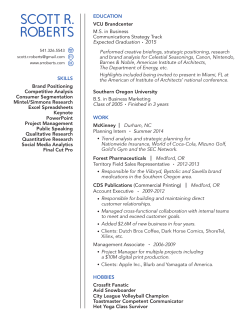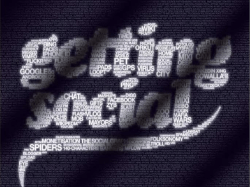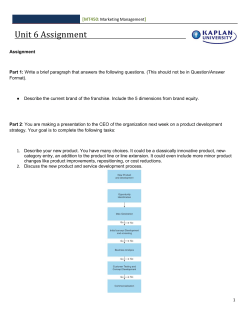
Lura Forcum - BBR Accelerator 2015
Lura Forcum EDUCATION Kelley School of Business ∙ Indiana University lforcum@indiana.edu ∙ (773) 505-2146 Kelley School of Business, Indiana University, Ph.D., Marketing 2010–present University of Chicago, M.A., Social service administration 2002–2004 University of North Carolina–Chapel Hill, B.A., Political science 1998–2001 RESEARCH INTERESTS I am a consumer behavior researcher with interests in two main theoretical areas. First, I study the antecedents and consequences of social cognition being elicited by brands (working papers 2 and 4). Second, I examine power and control’s influence on consumption outcomes from a variety of perspectives—consumer’s control in shopping contexts (working paper 3), cultural beliefs about power distance (working paper 1), or attempts to control by brands (working paper 2). Most of my work focuses on a single substantive area, which is novel types of consumer–brand interactions that have been enabled by technology. This includes things such as a social media (working papers 2 and 4) but also virtual trial interfaces (working paper 3). PUBLICATIONS Krishnan, Shanker and Lura Forcum (2014), “Consumer Memory Dynamics: Effects of Branding and Advertising on Formation, Stability, and Use of Consumer Memory,” Ch. 19 in Handbook of Applied Memory Research, Tim Perfect and Steve Lindsay (eds.). Thousand Oaks, CA: SAGE Publications. Aguinis, Herman, Lura Forcum, and Harry Joo (2013), “Using Market Basket Analysis in Management Research,” Journal of Management, 39 (7), 1799–1824. WORKING PAPERS 1. “Does a Dollar Get You a Dollar’s Worth of Merchandise? The Impact of Power Distance Belief on Price-Quality Judgments.” Invited for third-round review, Journal of Consumer Research. With Ashok Lalwani. 2. “You Can’t Make Me, But You Should Try: Benefits of Controlling Behavior by Brands.” Four of five studies complete, preparing for submission to Journal of Consumer Research. With Shanker Krishnan. • Finalist, Mary Kay / Academy of Marketing Science Dissertation Proposal Competition (overall winner to be selected based on presentation at May AMS Conference) (2015) • Honorable mention, Marketing Science Institute Clayton Dissertation Proposal Competition (2014) • Best proposal award winner, Society for Marketing Advances Doctoral Dissertation Proposal Competition (2014) 3. “Mirror, Mirror on the Wall: When Does Virtual Trial Lead to Positive Consumer Outcomes?” Revising for submission to Journal of Marketing Research. With Arun Lakshmanan and Shanker Krishnan. 4. “Putting Yourself in the Brand’s Shoes: Negative Effects of Perspective Taking.” Two studies complete, target: Journal of Consumer Research. With Shanker Krishnan. PRESENTATIONS “Social Cognition and Brands.” Guest Lecture in MBA Consumer Insights course, Indiana University. February 2015. “You Can’t Make Me, But You Should Try: Benefits of Controlling Behavior by Brands,” University of Kansas, Lawrence, KS. October 2014. “Mirror, Mirror on The Wall: The Dark Side of Product Visualization,” 44th Annual Haring Symposium, Bloomington, IN. April 2014. “The Dark Side of Product Visualization: Negative Effects of Imagery.” Competitive Paper, Association for Consumer Research Annual Conference, Chicago, IL. October 2013. Discussant for 43rd Annual Haring Symposium, Bloomington, IN. March 2013. “Using Market Basket Analysis in Management Research.” Academy of Management Conference, Boston, MA. August 2012. SERVICE Trainee reviewer, Journal of Consumer Research Student reviewer, Association for Consumer Research AWARDS AND HONORS Mentee, Institute for Brands and Brand Relationships Accelerator Workshop (2015) Finalist, Mary Kay / Academy of Marketing Science Dissertation Proposal Competition (2015) Academy of Marketing Science Doctoral Consortium Fellow (2015) Mittelstaedt Doctoral Symposium, Presenter for Indiana University (2015) Honorable mention, Marketing Science Institute Clayton Dissertation Proposal Competition (2014) Best proposal award winner, Society for Marketing Advances Doctoral Dissertation Proposal Competition (2014) Haring Symposium, Presenter for Indiana University (2014) Haring Symposium, Discussant for Indiana University (2013) Dean’s Fellowship, Kelley School of Business, Indiana University (2010) TEACHING EXPERIENCE Marketing Strategy (M450): senior capstone class with computer simulation Spring 2014 6.23 / 7 Instructor is outstanding (1 = low, 7 = high) DISSERTATION Committee: Shanker Krishnan (chair), Ashok Lalwani, Adam Duhachek, and Eliot Smith. Forcum, Lura and Shanker Krishnan, “You Can’t Make Me, But You Should Try: Benefits of Controlling Behavior by Brands.” Two studies complete, manuscript in preparation. Target: Journal of Consumer Research. Firms wish to control consumers’ behavior, most obviously by getting them to purchase products, but also in other manners, such as having them disclose information to the company or recommend its products to others. Social media activity intended to increase consumer engagement with the brand, such as having people share or otherwise respond to the brand’s posts, is also an attempt at control. In such cases, the firm attempts to cause the consumer to carry out a particular action, without offering anything in return. Intuitively, most adults should object to having others, including firms, manipulate or control their behavior. We would expect any person or entity that engages in a control attempt to be unlikely to succeed in changing a person’s behavior, but instead to elicit anger, annoyance, and dislike. However, this research seeks to demonstrate that controlling behavior by firms may actually have beneficial effects on consumer attitudes. This is because a firm that seems controlling may be more likely to be attributed a mind, leading it to be viewed as more anthropomorphic. This increased humanness leads to downstream effects in which consumers are more likely to feel concern for or a desire to help the brand. For example, people may be more accepting of a surcharge intended to help a struggling brand if it is perceived as more humanlike. They may also view intentional harm as more problematic when it is done to an anthropomorphic, rather than non-anthropomorphic brand. While the marketing literature has examined brand and product anthropomorphism with explicit cues suggesting humanness, such as a human-like form or face (Kim and McGill, 2011) or intentions (Aggarwal and McGill, 2011), the present work examines a further form of anthropomorphism, attributing a mind to the brand. Mind attribution is a form of anthropomorphism because only humans have minds with emotion, intention, and cognition (Kozak, Marsh and Wegner, 2006). Furthermore, mind attribution happens intuitively, so that individuals may not be consciously aware they are attributing a mind to a non-human agent (ibid.). In the case of a brand, they consumers may not recognize that they have anthropomorphized it, nor that doing so affects their attitudes and behaviors toward it. In five experiments, I provide evidence of the relationship between a control attempt by a brand and increased anthropomorphism of the brand, and increased supportive behaviors and concern for the brand. I also show empirical evidence of the mediating role of anthropomorphism. These experiments have strong convergent validity due to the use of different manipulations of control attempt, different brands, and different measures of brand anthropomorphism and moral care and concern for the brand. Two further experiments investigate the boundary conditions of the hypothesized effect with the use of moderating variables. Enhanced mind detection abilities attenuate the effect by making consumers less likely to infer the presence of a mind as a result of the control attempt. This consequently decreases anthropomorphism and support and concern for the brand. Brand reputation reverses the effect previously documented, such that a brand with a reputation for harmful behavior toward the consumer is perceived as more intentional, and thus is attributed greater mind and accorded greater moral care and concern when it does not engage in a control attempt (vs. a brand with a neutral reputation). However, when a brand with a negative reputation does engage in a control attempt, it seems humanlike, and thus is attributed less mind and accorded less moral concern (vs. a brand with a neutral reputation). This work offers a number of important contributions to both the social cognition and marketing anthropomorphization literatures. First, it considers a novel process of brand and product anthropomorphization—via mind attribution. This is not only of theoretical interest, as minimal linguistic cues suggest complex human-like traits, but it is also of managerial interest, as such anthropomorphization methods may be easier to implement across various types of brand images. This work also shows that a firm action that people do not like can nonetheless have positive outcomes. DOCTORAL COURSEWORK Statistics for Research I and II Multivariate Data Analysis Structural Equation Modeling Marketing Models Research Methods Behavior in Markets Special Topics in Marketing (Consumer Behavior) Special Topics in Marketing (Innovation) Special Topics in Marketing (Branding) Managerial Research in Marketing I and II Social Cognition Group and Intergroup Processes Social Perception Neuroimaging: Theory and Methods Herman Aguinis / Frank Acito William Wyatt Scott MacKenzie Hai Che Phil Podsakoff Shanker Krishnan Shanker Krishnan Rebecca Slotegraaf Neil Morgan Neil Morgan / Rebecca Slotegraaf Eliot Smith Eliot Smith Ed Hirt Tom James PRIOR EXPERIENCE Communications Manager Indiana University, Kelley School of Business 2008–2010 Communications Associate Mercatus Center at George Mason University 2007–2008 Publications and Communications Manager Consortium on Chicago School Research at the University of Chicago 2004–2007 PROFESSIONAL AFFLILATIONS Association for Consumer Research, American Marketing Association, Society for Consumer Psychology REFERENCES Shanker Krishnan Whirlpool Professor of Marketing Kelley School of Business, Indiana University Phone: (812) 855-1210 Email: skrishna@indiana.edu Adam Duhachek Nestlé-Hustad Associate Professor of Marketing Kelley School of Business, Indiana University Phone: (812) 855-1099 Email: aduhache@indiana.edu Ashok Lalwani Associate Professor of Marketing Kelley School of Business, Indiana University Phone: (812) 855-1160 Email: lalwani@indiana.edu Eliot Smith War Years Chancellor’s Professor Department of Psychological and Brain Sciences, Indiana University Phone: (812) 856-0196 Email: esmith4@indiana.edu ABSTRACTS FOR PUBLISHED PAPERS, PAPERS UNDER REVIEW, AND SELECT RESEARCH IN PROGRESS Krishnan, Shanker and Lura Forcum (2014), “Consumer Memory Dynamics: Effects of Branding and Advertising on Formation, Stability, and Use of Consumer Memory,” Ch. 19 in Handbook of Applied Memory Research, Tim Perfect and Steve Lindsay (eds.). Thousand Oaks, CA: SAGE Publications. Memory plays an important role in various aspects of consumer behavior. In accordance with its importance, researchers in this domain have indeed explored various aspects of memory in great detail. For example, memory interference, false memories, misinformation, repetition, as well as the spacing effect have been subject to systematic inquiry. On the other hand, other aspects of memory have received scant attention. For example, studies of memory for sensory attributes and affect, metacognitive influences, linguistic effects and individual differences have unearthed more questions than have been answered. In this chapter, marketing research into memory in its multiple roles— mediator, moderator, independent variable, and process—as well as measures of memory are examined. A wide range of memory research from consumer behavior is reviewed and an outlook for further research in this domain is given. Aguinis, Herman, Lura Forcum, and Harry Joo (2013), “Using Market Basket Analysis in Management Research,” Journal of Management, 39 (7), 1799–1824. Market basket analysis (MBA), also known as association rule mining or affinity analysis, is a data-mining technique that originated in the field of marketing and more recently has been used effectively in other fields, such as bioinformatics, nuclear science, pharmacoepidemiology, immunology, and geophysics. The goal of MBA is to identify relationships (i.e., association rules) between groups of products, items, or categories. We describe MBA and explain that it allows for inductive theorizing; can address contingency (i.e., moderated) relationships; does not rely on assumptions such as linearity, normality, and residual equal variance, which are often violated when using general linear model–based techniques; allows for the use of data often considered “unusable” and “messy” in management research (e.g., data not collected specifically for research purposes); can help build dynamic theories (i.e., theories that consider the role of time explicitly); is suited to examine relationships across levels of analysis; and is practitioner friendly. We explain how the adoption of MBA is likely to help bridge the much-lamented micro–macro and science–practice divides. We also illustrate that use of MBA can lead to insights in substantive management domains, such as human resource management (e.g., employee benefits), organizational behavior (e.g., dysfunctional employee behavior), entrepreneurship (e.g., entrepreneurs’ identities), and strategic management (e.g., corporate social responsibility). We hope our article will serve as a catalyst for the adoption of MBA as a novel methodological approach in management research. Lalwani, Ashok and Lura Forcum, “Does a Dollar Get You a Dollar’s Worth of Merchandise?: The Impact of Power Distance Belief on Price-Quality Judgments.” Invited for third-round review, Journal of Consumer Research. Seven studies examined the link between power distance belief (PDB)—the acceptance and endorsement of power disparities in society—and the tendency to make price-quality judgments (i.e., to use the price of a product to judge its quality), the underlying processes, and boundary conditions. Results suggested that consumers high (vs. low) in PDB have a greater tendency to use price to judge quality because they have a greater need for structure, which makes them more likely to discriminate between brands and rank them based on a salient attribute such as price. The relationships held regardless of whether the price-quality relation was assessed using a standard self-report scale or via actual product judgments, and whether PDB and need for structure were measured or manipulated. The effect was found to be independent of cultural self-construal and risk aversion, was mediated by a need for structure, and disappeared when participants encountered organized or disorganized environments (but emerged when they encountered neutral ones), when participants’ perceptions of control were threatened or enhanced (but emerged when they were unchanged), or when social density was high or low (but emerged when it was moderate). Theoretical implications are discussed. Lakshmanan, Arun, Lura Forcum, and Shanker Krishnan, “Mirror, Mirror on the Wall: The Dark Side of Product Visualization.” Revising for submission to the Journal of Marketing Research. Consumers try products to evaluate whether they like it. With the increasing use of online technologies, many retailers facilitate virtual product trial. One particular platform in virtual trial is to enable consumers to create images of themselves wearing or using products. With such a feature, the question is whether seeing oneself in the product usage leads to positive evaluations of the product. Across four experiments, we show that when consumers use their own image (versus a standard image) and have control over the process, consumer evaluations are positive. In contrast, with limited control over the process, evaluations are less positive with their own image. We propose that this pattern emerges because the images elicit scrutiny and heightened awareness of the self, which influences productrelated outcomes. Thus, we contribute to the literature by outlining a scrutiny-based contingency model that explains both positive and negative effects of using self-images in virtual trial.
© Copyright 2025









